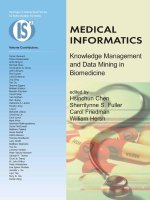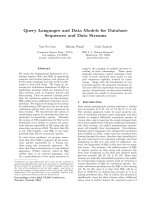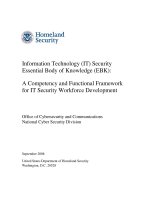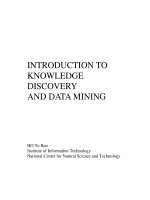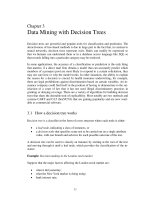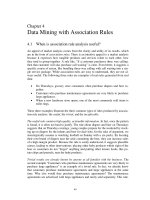Terrorism informatics knowledge management and data mining for homeland security chen, reid, sinai, silke ganor 2008 01 11
Bạn đang xem bản rút gọn của tài liệu. Xem và tải ngay bản đầy đủ của tài liệu tại đây (12.82 MB, 640 trang )
TERRORISM
INFORMATICS
Knowledge Management and
Data Mining for Homeland
Security
INTEGRATED SERIES IN INFORMATION SYSTEMS
Series Editors
Professor Ramesh Sharda
Prof. Dr. Stefan Voß
Oklahoma State University
Universität Hamburg
Other published titles in the series:
E-BUSINESS MANAGEMENT: Integration of Web Technologies with Business
Models/ edited by Michael J. Shaw
VIRTUAL CORPORATE UNIVERSITIES: A Matrix of Knowledge and Learning
for the New Digital Dawn/ Walter R.J. Baets & Gert Van der Linden
SCALABLE ENTERPRISE SYSTEMS: An Introduction to Recent Advances/
edited by Vittal Prabhu, Soundar Kumara, Manjunath Kamath
LEGAL PROGRAMMING: Legal Compliance for RFID and Software Agent
Ecosystems in Retail Processes and Beyond/ Brian Subirana and Malcolm Bain
LOGICAL DATA MODELING: What It Is and How To Do It/ Alan Chmura and
J. Mark Heumann
DESIGNING AND EVALUATING E-MANAGEMENT DECISION TOOLS: The
Integration of Decision and Negotiation Models into Internet-Multimedia
Technologies/ Giampiero E.G. Beroggi
INFORMATION AND MANAGEMENT SYSTEMS FOR PRODUCT
CUSTOMIZATION/ Thorsten Blecker et al
MEDICAL INFORMATICS: Knowledge Management and Data Mining in
Biomedicine/ edited by Hsinchun Chen et al
KNOWLEDGE MANAGEMENT AND MANAGEMENT LEARNING:
Extending the Horizons of Knowledge-Based Management/ edited by Walter
Baets
INTELLIGENCE AND SECURITY INFORMATICS FOR INTERNATIONAL
SECURITY: Information Sharing and Data Mining/ Hsinchun Chen
ENTERPRISE COLLABORATION: On-Demand Information Exchange for
Extended Enterprises/ David Levermore & Cheng Hsu
SEMANTIC WEB AND EDUCATION/ Vladan Devedžić
INFORMATION SYSTEMS ACTION RESEARCH: An Applied View of
Emerging Concepts and Methods/ Ned Kock
ONTOLOGIES: A Handbook of Principles, Concepts and Applications/ edited
by Raj Sharman, Rajiv Kishore, Ram Ramesh
METAGRAPHS AND THEIR APPLICATIONS/ Amit Basu and Robert W.
Blanning
SERVICE ENTERPRISE INTEGRATION: An Enterprise Engineering
Perspective/ Cheng Hsu
DIGITAL GOVERNMENT: E-Government Research, Case Studies, and
Implementation/ Chen et al
TERRORISM
INFORMATICS
Knowledge Management and
Data Mining for Homeland
Security
edited by
Hsinchun Chen
Edna Reid
Joshua Sinai
Andrew Silke
Boaz Ganor
Editors
Hsinchun Chen
University of Arizona
Tucson, AZ, USA
Edna Reid
Clarion University
Clarion, PA, USA
Joshua Sinai
The Analysis Corporation
McLean, VA, USA
Andrew Silke
University of East London
United Kingdom
Boaz Ganor
Lauder School of Government & Diplomacy
Herzliya, Israel
Series Editors
Ramesh Sharda
Oklahoma State University
Stillwater, Oklahoma, USA
ISBN-13: 978-0-387-71612-1
Stefan Voß
Universität Hamburg
Germany
e-ISBN-13: 978-0-387-71613-8
Library of Congress Control Number: 2008925539
© 2008 by Springer Science+Business Media, LLC
All rights reserved. This work may not be translated or copied in whole or in part without the written
permission of the publisher (Springer Science+Business Media, LLC, 233 Spring Street, New York,
NY 10013, USA), except for brief excerpts in connection with reviews or scholarly analysis. Use in
connection with any form of information storage and retrieval, electronic adaptation, computer
software, or by similar or dissimilar methodology now know or hereafter developed is forbidden.
The use in this publication of trade names, trademarks, service marks and similar terms, even if the
are not identified as such, is not to be taken as an expression of opinion as to whether or not they are
subject to proprietary rights.
Printed on acid-free paper.
9 8 7 6 5 4 3 2 1
springer.com
TABLE OF CONTENTS
Preface .................................................................................................... xv
Editor Biographies ................................................................................. xix
Author Biographies .............................................................................. xxv
UNIT I.
METHODOLOGICAL ISSUES IN
TERRORISM RESEARCH
Chapter 1. Domain Mapping of Contemporary Terrorism
Research
Edna Reid and Hsinchun Chen
Chapter Overview ................................................................................................ 3
1. Introduction................................................................................................... 4
2. Related Work ................................................................................................ 4
3. Research Design............................................................................................ 8
4. Results ........................................................................................................ 11
5. Conclusion .................................................................................................. 20
6. Acknowledgements ..................................................................................... 21
References ......................................................................................................... 21
Appendix: List of 42 Influential Terrorism Researchers ..................................... 23
Suggested Readings ........................................................................................... 26
Online Resources ............................................................................................... 26
Discussion Questions ......................................................................................... 26
Chapter 2. Research on Terrorism: A Review of the Impact of 9/11
and the Global War on Terrorism
Andrew Silke
Chapter Overview .............................................................................................. 27
1. Introduction................................................................................................. 28
2. The Nature of This Review.......................................................................... 32
3. Trends in Data-Gathering and Analysis........................................................ 33
4. Research on Terrorist Groups ...................................................................... 38
5. Research on Terrorist Tactics....................................................................... 41
6. Some Conceptual Issues .............................................................................. 44
7. Conclusions................................................................................................. 46
References ......................................................................................................... 48
Suggested Readings ........................................................................................... 49
Discussion Questions ......................................................................................... 49
v
vi
Table of Contents
Chapter 3. Who Are the Key Figures in “Terrorism Studies”?
Sam Raphael
Chapter Overview .............................................................................................. 51
1. Introduction................................................................................................. 52
2. Constructing the Framework: The Multiplicity of “Terrorism Studies,”
the Role of the Audience, and the Importance of Methdological Rigor.......... 53
3. Employing the Framework: Selecting the Time Period;
Constructing the Research Community ........................................................ 56
4. Constructing the Audience........................................................................... 59
5. Measuring the Opinions of the Relevant Audience:
What Does the Peer Research Community Think?........................................ 60
6. Establishing the Threshold: Exactly
What Determines an Expert as Key? ............................................................ 62
7. Conclusion .................................................................................................. 67
References and Footnotes ................................................................................... 69
Suggested Readings ........................................................................................... 72
Discussion Questions ......................................................................................... 72
Chapter 4. Interviewing Terrorists: A Case for Primary Research
John Horgan
Chapter Overview .............................................................................................. 73
1. Introduction................................................................................................. 74
2. Procuring Interviews ................................................................................... 75
3. A Case Illustration: Interviews with the IRA ............................................... 79
4. Finding and “Collecting” Participants .......................................................... 80
5. A Case Example: Interviewing a Terrorist................................................... 85
6. Interview Considerations ............................................................................. 89
7. Issues of Validity and Reliability ................................................................. 94
8. Conclusions................................................................................................. 96
Post-Script ......................................................................................................... 97
References ......................................................................................................... 97
Suggested Readings ........................................................................................... 99
Discussion Questions ......................................................................................... 99
Chapter 5. Resolving a Terrorist Insurgency by Addressing
Its Root Causes
Joshua Sinai
Chapter Overview ............................................................................................ 101
1. Introduction............................................................................................... 102
2. Why Root Causes Are Significant.............................................................. 103
3. How to Resolve a Conflict’s Root Causes .................................................. 106
4. Conclusion ................................................................................................ 111
Table of Contents
vii
References and Footnotes ................................................................................. 112
Suggested Readings ......................................................................................... 114
Online Resources ............................................................................................. 114
Discussion Questions ....................................................................................... 114
Chapter 6. A Quantitative Analysis of “Root Causes of Conflict”
Mihaela Bobeica, Jean-Paul Jéral, Teofilo Garcia, Clive Best
Chapter Overview ............................................................................................ 115
1. Introduction............................................................................................... 116
2. Conflict Indicators and Automatic Data Analysis for Early Warning .......... 117
3. LSA Applied to English Articles in EMM.................................................. 120
4. Results and Discussion .............................................................................. 124
5. Conclusions and Future Work.................................................................... 131
References ....................................................................................................... 132
Suggested Readings ......................................................................................... 133
Online Resources ............................................................................................. 133
Discussion Questions ....................................................................................... 133
Appendix 1: Tables .......................................................................................... 134
Appendix 2: Conflict Indicators........................................................................ 136
Appendix 3: Figures ........................................................................................ 137
Appendix 4: Word Lists .................................................................................. 139
Chapter 7. Countering Terrorism with Knowledge
James O. Ellis III
Chapter Overview ............................................................................................ 141
1. Introduction............................................................................................... 142
2. Problems in Researching Terrorism ........................................................... 142
3. Problems in Terrorism Research ................................................................ 144
4. Problems in Terrorism Databases............................................................... 145
5. MIPT as an Information Clearinghouse...................................................... 147
6. MIPT-Funded Terrorism Databases ........................................................... 149
7. MIPT Terrorism Knowledge Base ............................................................. 150
8. Better Knowing What We Know about Terrorism ...................................... 151
9. Acknowledgements ................................................................................... 153
References ....................................................................................................... 153
Suggested Readings ......................................................................................... 154
Online Resources ............................................................................................. 154
Discussion Questions ....................................................................................... 155
Chapter 8. Toward a Target-specific Method of Threat Assessment
Yael Shahar
Chapter Overview ............................................................................................ 157
viii
Table of Contents
1.
2.
3.
4.
5.
Introduction............................................................................................... 158
Methodology............................................................................................. 158
Organization-specific Indicators ................................................................ 160
Synthesis................................................................................................... 169
Summary: Scenarios Most Likely to Be Carried out by
Relevant Terrorist Groups.......................................................................... 171
6. Conclusion ................................................................................................ 172
Suggested Readings ......................................................................................... 173
Online Resources ............................................................................................. 174
Discussion Questions ....................................................................................... 174
Chapter 9. Identifying and Exploiting Group Learning Patterns for
Counterterrorism
Horacio R. Trujillo and Brian A. Jackson
Chapter Overview ............................................................................................ 175
1. Introduction............................................................................................... 176
2. Organizational Learning ............................................................................ 177
3. A Four Stage Model of Organizational Learning ........................................ 178
4. Paths of Organizational Learning............................................................... 182
5. Determinants of Organizational Learning................................................... 183
6. How an Organizational Learning Model Can Inform the
Design of Terrorism Informatics Systems .................................................. 186
7. Conclusions and Discussion....................................................................... 190
8. Acknowledgements ................................................................................... 191
Notes ............................................................................................................... 192
References ....................................................................................................... 194
Suggested Readings ......................................................................................... 195
Online Resources ............................................................................................. 195
Discussion Questions ....................................................................................... 195
Chapter 10. Homeland Insecurity: Data Mining, Privacy, Disclosure
Limitation, and the Hunt for Terrorists
Stephen E. Fienberg
Chapter Overview ............................................................................................ 197
1. Introduction ............................................................................................. 198
2. Homeland Security and the Search for Terrorists ...................................... 200
3. Matching and Record Linkage Methods ................................................... 203
4. Encryption, Multi-party Computation, and Privacypreserving Datamining............................................................................. 205
5. Selective Revelation, Risk-utility Tradeoff,
and Disclosure Limitation Assessment ..................................................... 207
6. Analyzing Network Data Based on Transactions ...................................... 210
Table of Contents
ix
7. Conclusions............................................................................................. 212
8. Acknowledgments ................................................................................... 214
Notes ............................................................................................................... 214
References ....................................................................................................... 215
Suggested Readings ......................................................................................... 217
Discussion Questions ....................................................................................... 218
UNIT II.
TERRORISM INFORMATICS TO SUPPORT
PREVENTION, DETECTION, AND RESPONSE
Chapter 11. Case Study of Jihad on the Web: A Web Mining Approach
Hsinchun Chen, Jialun Qin, Edna Reid, Yilu Zhou, and Marc Sageman
Chapter Overview ............................................................................................ 221
1. Introduction............................................................................................... 222
2. Previous Research ..................................................................................... 222
3. Proposed Approach ................................................................................... 225
4. Analysis Results........................................................................................ 228
5. Discussion and Future Work...................................................................... 233
References ....................................................................................................... 234
Suggested Readings ......................................................................................... 235
Online Resources ............................................................................................. 235
Discussion Questions ....................................................................................... 235
Chapter 12. Studying Global Extremist Organizations’ Internet
Presence Using the D ark W eb Attribute System: A Three Region
Comparison Study
Jialun Qin, Yilu Zhou, Edna Reid, and Hsinchun Chen
Chapter Overview ............................................................................................ 237
1. Introduction............................................................................................... 238
2. Literature Review...................................................................................... 239
3. Studying Global Extremist Organizations’ Internet Usage: A ThreeRegion Empirical Study............................................................................. 243
4. Conclusions and Future Directions............................................................. 261
References ....................................................................................................... 263
Suggested Readings ......................................................................................... 265
Online Resources ............................................................................................. 265
Discussion Questions ....................................................................................... 266
x
Table of Contents
Chapter 13. Content Analysis of Jihadi Extremist Groups’ Videos
Arab Salem, Edna Reid, and Hsinchun Chen
Chapter Overview ............................................................................................ 267
1. Introduction ............................................................................................. 268
2. Related Work........................................................................................... 269
3. Methodology ........................................................................................... 272
4. Results..................................................................................................... 276
5. Conclusion .............................................................................................. 280
6. Acknowledgements.................................................................................. 281
References ....................................................................................................... 281
Suggested Readings ......................................................................................... 283
Online Resources ............................................................................................. 283
Discussion Questions ....................................................................................... 284
Chapter 14. Analysis of Affect Intensities in Extremist Group Forums
Ahmed Abbasi and Hsinchun Chen
Chapter Overview ............................................................................................ 285
1. Introduction ............................................................................................. 286
2. Related Work........................................................................................... 287
3. Research Gaps and Questions................................................................... 292
4. Research Questions.................................................................................. 293
5. Research Design ...................................................................................... 294
6. System Design......................................................................................... 294
7. Evaluation ............................................................................................... 297
8. Results..................................................................................................... 300
9. Conclusions............................................................................................. 303
References ....................................................................................................... 304
Suggested Readings ......................................................................................... 306
Online Resources ............................................................................................. 306
Discussion Questions ....................................................................................... 307
Chapter 15. Document Selection for Extracting Entity and
Relationship Instances of Terrorist Events
Zhen Sun, Ee-Peng Lim, Kuiyu Chang, Maggy Anastasia Suryanto,
and Rohan Kumar Gunaratna
Chapter Overview ............................................................................................ 309
1. Introduction ............................................................................................. 310
2. Literature Review .................................................................................... 313
3. Domain Specific Event Entity Relation
Extraction Task with Document Ranking ................................................. 317
4. Case Studies ............................................................................................ 325
5. Conclusions and Discussion ..................................................................... 343
6. Acknowledgements.................................................................................. 344
Table of Contents
xi
References ....................................................................................................... 344
Suggested Readings ......................................................................................... 346
Online Resources ............................................................................................. 346
Discussion Questions ....................................................................................... 346
Chapter 16. Data Distortion Methods and Metrics in a Terrorist
Analysis System
Shuting Xu and Jun Zhang
Chapter Overview ............................................................................................ 347
1. Introduction ............................................................................................. 348
2. Terrorist Analysis System ........................................................................ 350
3. Data Distortion ........................................................................................ 350
4. Data Distortion Measures......................................................................... 354
5. Utility Measure........................................................................................ 357
6. Experiments and Results .......................................................................... 358
7. Conclusions and Discussions.................................................................... 361
References ....................................................................................................... 362
Suggested Readings ......................................................................................... 364
Online Resources ............................................................................................. 364
Discussion Questions ....................................................................................... 364
Chapter 17. Content-Based Detection of Terrorists Browsing the Web
Using an Advanced Terror Detection System (ATDS)
Yuval Elovici, Bracha Shapira, Mark Last, Omer Zaafrany, Menahem
Friedman, Moti Schneider, and Abraham Kandel
Chapter Overview ............................................................................................ 365
1. Introduction ............................................................................................. 366
2. Related Work........................................................................................... 367
3. Advanced Terrorist Detection System ...................................................... 368
4. Evaluation ............................................................................................... 374
5. Conclusions and Discussion ..................................................................... 381
6. Acknowledgements.................................................................................. 382
References ....................................................................................................... 382
Suggested Readings ......................................................................................... 384
Online Resources ............................................................................................. 384
Discussion Questions ....................................................................................... 384
Chapter 18. Text Mining the Biomedical Literature for
Identification of Potential Virus/Bacterium as Bio-terrorism Weapons
Xiaohua Hu, Xiaodan Zhang, Daniel Wu, Xiaohua Zhou, and Peter Rumm
Chapter Overview ............................................................................................ 385
1. Introduction ............................................................................................. 386
xii
Table of Contents
2. Related Works ......................................................................................... 387
3. Background of Virus and Bacterium......................................................... 387
4. Method.................................................................................................... 389
5. Experimental Results ............................................................................... 394
6. Potential Significance for Public Health and Homeland Security............... 404
7. Acknowledgements.................................................................................. 404
References ....................................................................................................... 404
Suggested Readings ......................................................................................... 405
Online Resources ............................................................................................. 405
Discussion Questions ....................................................................................... 405
Chapter 19. Leveraging One-Class SVM and Semantic Analysis to
Detect Anomalous Content
Ozgur Yilmazel, Svetlana Symonenko, Niranjan Balasubramanian,
and Elizabeth D. Liddy
Chapter Overview ............................................................................................ 407
1. Introduction ............................................................................................. 408
2. Overview of Related Work....................................................................... 409
3. Case Study: One-class Categorization Approach to
the Problem of Identifying Anomalous Content ........................................ 411
4. Conclusions and Discussion ..................................................................... 420
References ....................................................................................................... 421
Acknowledgements ......................................................................................... 423
Suggested Readings ........................................................................................ 423
Online Resources ............................................................................................. 423
Discussion Questions ....................................................................................... 423
Chapter 20. Individual and Collective Analysis of Anomalies
in Message Traffic
D.B. Skillicorn
Chapter Overview ............................................................................................ 425
1. Introduction ............................................................................................. 426
2. Analysis of Single Messages .................................................................... 428
3. Analysis of Multiple Messages................................................................. 435
4. Conclusions............................................................................................. 447
5. Acknowledgements.................................................................................. 448
References ....................................................................................................... 448
Suggested Readings ......................................................................................... 449
Discussion Questions ....................................................................................... 449
Table of Contents
xiii
Chapter 21. Addressing Insider Threat through Cost-Sensitive
Document Classification
Young-Woo Seo and Katia Sycara
Chapter Overview ............................................................................................ 451
1. Introduction ............................................................................................. 452
2. Related Work........................................................................................... 454
3. Overview................................................................................................. 455
4. Classification for Confidential Authorization............................................ 457
5. Experiments............................................................................................. 461
6. Conclusion .............................................................................................. 468
7. Acknowledgments ................................................................................... 470
References ....................................................................................................... 470
Suggested Readings ......................................................................................... 471
Online Resources ............................................................................................. 472
Discussion Questions ....................................................................................... 472
Chapter 22. Using Web Mining and Social Network Analysis to Study
the Emergence of Cyber Communities in Blogs
Michael Chau and Jennifer Xu
Chapter Overview ............................................................................................ 473
1. Introduction ............................................................................................. 474
2. Research Background .............................................................................. 475
3. Research Questions.................................................................................. 479
4. A Framework for Blog Collection and Analysis........................................ 480
5. A Case Study on Xanga ........................................................................... 483
6. Conclusion and Future Directions............................................................. 488
7. Acknowledgements.................................................................................. 489
References ....................................................................................................... 489
Appendix ......................................................................................................... 492
Suggested Readings ......................................................................................... 493
Online Resources ............................................................................................. 493
Discussion Questions ....................................................................................... 493
Chapter 23. Automatic Extraction of Deceptive Behavioral Cues
from Video
Thomas O. Meservy, Matthew L. Jensen, W. John Kruse, Judee K. Burgoon,
and Jay F. Nunamaker Jr.
Chapter Overview ............................................................................................ 495
1. Introduction ............................................................................................. 496
2. Literature Review .................................................................................... 496
3. Research Method and Examples............................................................... 501
xiv
Table of Contents
4. Experiments and Results .......................................................................... 510
5. Conclusion .............................................................................................. 512
6. Acknowledgements.................................................................................. 513
References ....................................................................................................... 513
Suggested Readings ......................................................................................... 515
Online Resources ............................................................................................. 515
Discussion Questions ....................................................................................... 516
Chapter 24. Situational Awareness Technologies for Disaster Response
Naveen Ashish, Ronald Eguchi, Rajesh Hegde, Charles Huyck,
Dmitri Kalashnikov, Sharad Mehrotra, Padhraic Smyth,
and Nalini Venkatasubramanian
Chapter Overview ............................................................................................ 517
1. Introduction ............................................................................................. 518
2. Situational Awareness.............................................................................. 523
3. Event Extraction ...................................................................................... 527
4. Event Data Management .......................................................................... 531
5. Event Analysis and Visualization ............................................................. 534
6. Artifacts .................................................................................................. 539
7. Conclusion .............................................................................................. 541
8. Acknowledgements.................................................................................. 542
References ....................................................................................................... 542
Online Resources ............................................................................................. 544
Questions for Discussion .................................................................................. 544
Author Index ................................................................................................ 545
Subject Index ............................................................................................... 547
PREFACE
Terrorism informatics is defined as the application of advanced
methodologies and information fusion and analysis techniques to acquire,
integrate, process, analyze, and manage the diversity of terrorism-related
information for national/international and homeland security-related
applications. These techniques are derived from disciplines such as
computer science, informatics, statistics, mathematics, linguistics, social
sciences, and public policy. Because the study of terrorism involves copious
amounts of information from multiple sources, data types, and languages,
information fusion and analysis techniques such as data mining, data
integration, language translation technologies, and image and video
processing are playing key roles in the future prevention, detection, and
remediation of terrorism 1 . Within the homeland security industry,
information fusion is defined as the use of computer technology to acquire
data from many sources, integrate this data into usable and accessible forms,
and interpret the results2. Although there has been substantial investment
and research in the application of computer technology to terrorism, much
of the literature in this emerging area is fragmented and often narrowly
focused within specific domains such as engineering, computer science,
computer security, information systems, knowledge management, and
biomedicine.
The goal of this edited volume is to present an interdisciplinary and
understandable review of terrorism informatics work for homeland security
along two dimensions: methodological issues in terrorism research,
including information infusion techniques to support terrorism prevention,
detection, and response; and legal, social, privacy, and data confidentiality
challenges and approaches.
SCOPE AND ORGANIZATION
This book has been grouped into two units. Unit I focuses on the
methodological issues in terrorism research including trends, achievements
and failures in terrorism research, methodological challenges in terrorism,
challenges in retrieving and sharing terrorism information resources, and
root causes of terrorism and the implications for terrorism informatics. It
1
2
National Research Council, 2003. Making the Nation Safer: the Roles of Science and Technology in Countering Terrorism, p11.
Ibid, p. 166.
xv
xvi
Preface
also attends to critical socio-technical topics relevant to information and
knowledge management such as privacy, data confidentiality, and legal
challenges. Unit I chapters address the following topics and concepts:
· Mapping the domain of terrorism research
· Identifying key terrorism researchers
· The impact on 9/11 on terrorism
· Primary sources for the study of terrorism
· Analyzing the root causes of terrorism
· The construction of information resources useful for the study of
terrorism
· Threat assessment and analysis
· Methods to support counterterrorism
· Data mining and privacy concerns
Unit 2 presents current research, including case studies, on the
application of terrorism informatics techniques (such as web mining, social
network analysis, and multimodal event extraction and analysis) to the
terrorism phenomenon. Unit 2 focuses on three major areas of terrorism
research: prevention, detection, and response as identified by the National
Research Council 3 and the U.S. White House’s Office of Science and
Technology Program (OSTP). 4 Unit III will present the critical
sociotechnical topics relevant to information and knowledge management:
social, privacy, data confidentiality, and legal challenges.
· Examining “Jihad” on the world wide web
· Comparing extremist groups websites across regions
· Analyzing extremist communications as manifested in web forums
· Terrorist analysis systems and detection
· Identification of potential bioterrorist weapons
· Detecting and analyzing anomalous content
· Examining “insider” threats
· Using web mining and social network analysis
· Video analysis and deception detection
· Situational awareness technologies for disaster response
3
4
Ibid., p. 167.
Zahn, M.A. and Strom, K.J., 2004, “Terrorism and the Federal Social Science Research
Agenda”. Edited by M. Deflem. In Terrorism and Counter-Terrorism: Criminological Perspectives. Elsevier p112.
Preface
xvii
CHAPTER STRUCTURE
Each chapter follows a consistent structure to ensure uniformity and ease
of use:
· Title
· Authors and affiliations
· Introduction: introduces the relevance and significance of the topic
· Literature review/Overview of the field: a systematic review of
related works in the topic area
· Case study/Methods/Examples: One or two detailed studies or
examples of selected techniques, systems, implementations and
evaluations
· Conclusion and discussion
· Acknowledgements
· References and notes
· Suggested readings
· Online resources
· Questions for discussion
The work is further enhanced by author and subject indexes at the back
of the book, intended to facilitate ease of access to the contents./
INTENDED AUDIENCE
The audience of the book is intentionally broad. It is intended to bring
useful knowledge to scientists, security professionals, counterterrorism
experts, and policy makers. It is also intended to serve as reference material
and as a textbook in graduate-level courses related to information security,
information policy, information assurance, information systems, terrorism,
and public policy. Readers will learn new concepts, technologies, and
practices developed in terrorism informatics through the comprehensive
reviews of recent work and detailed case studies presented in each chapter.
Students and researchers will broaden their understanding and knowledge in
these new research topics. Practitioners will be able to better evaluate and/or
employ new and alternative technologies for their current projects and future
work.
EDITOR BIOGRAPHIES
Dr. Hsinchun Chen is McClelland Professor of Management
Information Systems at the University of Arizona and Andersen Consulting
Professor of the Year (1999). He received the B.S. degree from the National
Chiao-Tung University in Taiwan, the MBA degree from SUNY Buffalo,
and the Ph.D. degree in Information Systems from the New York
University. Dr. Chen is a Fellow of IEEE and AAAS. He received the IEEE
Computer Society 2006 Technical Achievement Award. He is the
author/editor of 15 books, 17 book chapters, and more than 150 SCI journal
articles covering intelligence analysis, biomedical informatics, data/text/web
mining, digital library, knowledge management, and Web computing. His
recent books include: Intelligence and Security Informatics for International
Security: Information Sharing and Data Mining, and Digital Government:
E-Government Research, Case Studies, and Implementationi (Springer).
Dr. Chen was ranked eighth in publication productivity in Information
Systems (CAIS 2005) and first in Digital Library research (IP&M 2005) in
two recent bibliometric studies. He serves on ten editorial boards including:
ACM Transactions on Information System; ACM Journal on Educational
Resources in Computing; IEEE Transactions on Intelligent Transportation
Systems; IEEE Transactions on Systems, Man, and Cybernetics; Journal of
the American Society for Information Science and Technology; Decision
Support Systems; and International Journal on Digital Library. Dr. Chen
has served as a Scientific Counselor/Advisor to the National Library of
Medicine (USA), Academia Sinica (Taiwan), and the National Library of
China (China). He has been an advisor for major NSF, DOJ, NLM, DOD,
DHS, and other international research programs in digital government,
national security research, medical informatics, and digital library. Dr. Chen
is the founding director of the Artificial Intelligence Lab and Hoffman ECommerce Lab. The UA Artificial Intelligence Lab, which houses 25+
researchers, has received more than $20M in research funding from NSF,
NIH, NLM, DOD, DOJ, CIA, DHS, and other agencies over the past 17
years. Dr. Chen is the (founding) conference co-chair of the IEEE
International Conferences on Intelligence and Security Informatics (ISI)
2003-2007. The ISI conference, which has been sponsored by NSF, CIA,
DHS, and NIJ, has become the premiere meeting for international and
homeland security IT research. Dr. Chen’s COPLINK system, which has
been quoted as a national model for public safety information sharing and
analysis, has been adopted in more than 550 jurisdictions nation-wide.
COPLINK research had been featured in the New York Times, Newsweek,
Los Angeles Times, Washington Post, Boston Globe, and ABC News,
xix
xx
Editor Biographies
among others. The COPLINK project was selected as a finalist by the
prestigious International Association of Chiefs of Police (IACP)/Motorola
2003 Weaver Seavey Award for Quality in Law Enforcement in 2003.
COPLINK research has recently been expanded to border protection
(BorderSafe), disease and bioagent surveillance (BioPortal), and terrorism
informatics research (Dark Web), funded by NSF, CIA, and DHS. In
collaboration with Customs and Border Protection (CBP), the BorderSafe
project develops criminal network analysis and vehicle association mining
research for border-crosser risk assessment. The BioPortal system supports
interactive geospatial analysis and visualization, chief complaint
classification, and phylogenetic analysis for public health and biodefense. In
collaboration with selected international terrorism research centers and
intelligence agencies, the Dark Web project has generated one of the largest
databases in the world about extremist/terrorist-generated Internet contents
(web sites, forums, and multimedia documents). Dark Web research
supports link analysis, content analysis, web metrics analysis, multimedia
analysis, sentiment analysis, and authorship analysis of international
terrorism content. The project has been featured in the Associated Press,
Fox News, National Public Radio (NPR), the British Broadcasting
Corporation (BBC), the NSF Press, Discover Magazine, the Arizona
Republic, and the Toronto Star, among others. Dr. Chen is the founder of
the Knowledge Computing Corporation, a university spin-off company and
a market leader in law enforcement and intelligence information sharing and
data mining. Dr. Chen has also received numerous awards in information
technology and knowledge management education and research including:
AT&T Foundation Award, SAP Award, the Andersen Consulting Professor
of the Year Award, the University of Arizona Technology Innovation
Award, and the National Chaio-Tung University Distinguished Alumnus
Award.
Dr. Edna Reid is an Associate Professor at Clarion University,
Pennsylvania. Formerly, she was a senior research scientist and project
manager in the Artificial Intelligence Laboratory at the University of
Arizona, Tucson. She was an Associate Professor with Nanyang Business
School, NTU, Singapore, and the president of the Society of Competitive
Intelligence Professionals Singapore (SCIPSgp). Formerly, she was an
entrepreneur with an Internet start-up in Malaysia. In 1993, she joined the
Division of Information Studies, NTU. Prior to going to Asia, Edna was at
the School of Communication, Information and Library Studies, Rutgers
University. In 1990, she was a postdoctoral researcher at the University of
California, Berkeley, where she conducted research in terrorism information
services. She also served as a senior systems analyst and data analyst team
Editor Biographies
xxi
leader at private enterprises in both Germany and northern Virginia in the
U.S.. She has analytical and library sciences experience in the intelligence
community. Her areas of specialization include competitive intelligence,
web mining, and terrorism informatics. Her research focuses on web mining
of extremist groups' digital artifacts (e.g., web sites, forums, multimedia).
She has published in a number of journals, conference proceedings, and
edited collections. She received a Certificate in Management Information
Systems (MIS) from American University in 1984, and the DLS (Library
Science) degree from the University of Southern California in 1983. She
also holds a bachelors degree in Education from D.C. Teachers College and
a Masters Degree in library science from the University of Maryland.
Dr. Joshua Sinai is a Program Manager for counter-terrorism studies &
education at The Analysis Corporation (TAC) (www.theanalysiscorp.com),
in McLean, VA. His government contracts range from a project to map the
worldwide landscape of terrorism & counterterrorism studies to an
assessment of tribalism in Iraq. He also assists in developing curriculum on
counterterrorism analysis to TACLearn, TAC’s internal distance learning
educational program. Prior to joining TAC in June 2006, Dr. Sinai worked
at Logos Technologies and ANSER (Analytical Services), from which for
18 months he was seconded to function as a government official in the
Science & Technology Directorate, Department of Homeland Security,
where he managed a project on the social and behavioral components of
terrorism and its impact on society. As part of his duties, he co-chaired an
interagency working group, under the White House Office of Science &
Technology Policy, on how the social, behavioral and economic sciences
can contribute to counterterrorism, which produced a report on this subject
in April 2005. He also contributed to the formulation of the announcement
for proposals to create the DHS center on terrorism studies and served on
the evaluation committee to review all proposals. Dr. Sinai’s publications
include chapters in edited academic volumes, national security journals, and
his column on Terrorism Books appears regularly in the Washington Times’
book review section. He has also published newspaper articles on terrorists’
use of the Internet and how the special operations community approaches
counterterrorism. He is a frequent presenter at academic conferences on
terrorism & counterterrorism.
Dr. Sinai can be reached
at:
Dr. Andrew Silke currently holds a Chair in Criminology at the
University of East London where he is the Programme Director for
Terrorism Studies. He has a background in forensic psychology and has
worked both in academia and for government. His research and writings are
xxii
Editor Biographies
published extensively in academic journals, books and the popular press. He
is the author of over 100 articles and papers on subjects relating to terrorism,
and has given numerous papers and invited lectures on these topics at
conferences and universities across the world. In recent years, he has
worked with a wide range of scientific, government and law enforcement
agencies, including the U.S. Federal Bureau of Investigation, the United
States Department of Justice, the United States Department of Homeland
Security, NATO, the United States National Academy of Sciences, the
Royal Society, the United Nations, the European Defence Agency, the
European Commission, the Metropolitan Police and the House of
Commons. He has also provided risk assessment and acted as an expert
witness in several terrorism-related cases. Professor Silke serves by
invitation on both the European Commission’s Expert Group on Violent
Radicalisation, and the United Nations Roster of Terrorism Experts. He is
an Honorary Senior Research Associate of the renowned Centre for the
Study of Terrorism and Political Violence at the University of St Andrews
and is a Fellow of the University of Leicester. His work has taken him to
Northern Ireland, the Middle East and Latin America.
Dr. Boaz Ganor is the associate dean of the Lauder School of
Government, the founder and executive director of the International Policy
Institute for Counter-Terrorism (ICT), and the head of the Homeland
Security Studies program (Graduate degree, Executive program and
Bachelor specialization) at the Interdisciplinary Center Herzliya, Israel. He
is also the founder and Chairman of the International Counter Terrorism
Academic Community (ICTAC). In addition, Dr. Ganor is a senior fellow
of MIPT (The Memorial Institute for Prevention of Terrorism, Oklahoma
City, USA) and a member of the International Advisory Council of the
International Centre for Political Violence and Terrorism Research at the
Institute of Defense and Strategic Studies (IDSS), Nanyang Technological
University, The Republic of Singapore. Dr. Ganor is also a member of the
board of directors of ICSR – The International Centre for the Study of
Radicalization and Political Violence (a partnership of the University of
Pennsylvania (U.S.A.), the Interdisciplinary Center (Israel), King’s College
(London, U.K.), and The Jordanian Institute of Diplomacy). Past positions
for Dr. Ganor have included membership in the Israeli Delegation to the
Trilateral (American-Palestinian-Israeli) Committee for Monitoring
Incitement to Violence and Terrorism as well as the Israeli National
Committee for Homeland Security Technologies. He has served as an
advisor on counter-terrorism topics to the Israeli Ministry of Defense, the
Israeli Counter-Terrorism Coordinator in the Prime Minister’s office, Israel
National Security Council, and the Israeli Transportation Ministry during
Editor Biographies
xxiii
the peace talks with Jordan. In addition, he advised Prime Minister
Benjamin Nethanyahu on his book Fighting Terrorism. Dr. Ganor has been
widely published and some of his key works have included Israel’s
Counter-Terrorism Strategy – Efficacy versus Liberal–Democratic Values
(Political Science, The Hebrew University, Jerusalem, Israel, 2002), and
Terrorism and Public Opinion in Israel (Tel-Aviv University, Israel, 1989).
In addition, Dr. Ganor has written numerous articles on the topic of
terrorism and counterterrorism. His latest book, The Counter-Terrorism
Puzzle – A guide for decision makers (Transaction Publishers, 2005), is
currently being used as a textbook is several universities. Dr. Ganor is also
the editor of Trends in International Terrorism (2007), Hypermedia
Seduction for Terrorist Recruiting (2007), and Post Modern Terrorism
(2005).
AUTHOR BIOGRAPHIES
Ahmed Abbasi is a research associate at the Artificial Intelligence Lab
and a doctoral student in the Management Information Systems department
at the University of Arizona. He received his BS degree and MBA from
Virginia Tech. His research interests include text mining, computer
mediated communication, information visualization, and knowledge
management.
Naveen Ashish is a Research Scientist and Research Faculty Member at
the University of California, Irvine where he is affiliated with Calit2. He is
the project leader of the SAMI project on situational awareness, within the
larger (NSF funded) RESCUE project on advancing information
technologies for disaster response. His research interests and expertise span
various areas in data management and AI, including information integration,
information extraction, and information semantics. He received his PhD in
Computer Science from the University of Southern California in 2000 and
worked at the NASA Ames Research Center before joining UCI.
Niranjan Balasubramanian is currently a doctoral student at the Center
for Intelligent Information Retrieval (CIIR) in the Department of Computer
Science at the University of Massachusetts, Amherst. His research interests
include information retrieval, extraction, text classification and question
answering. Prior to joining CIIR, Balasubramanian was a Software Engineer
at the Center for Natural Language Processing where he participated in
research and development of several natural language processing
technologies and their applications.
Clive Best is a senior researcher within the “Support to External
Security” Unit at the JRC’s “Institute for the Protection and the Security of
the Citizen” in Ispra, Italy. With a background in information technology, he
is presently carrying our research on information processing, based on a
media monitor system (Europe Media Monitor-EMM) developed at the
Joint Research Centre. The Joint Research Centre (JRC) is one of the
directorates general of the European Commission and it includes seven
different research institutes located in several EU member states. The JRC’s
mission is to provide customer-driven scientific and technical support for
the conception, development, implementation and monitoring of EU
policies. It functions as a centre of science and technology reference for the
EU independent of commercial and national interests. The JRC supports the
policy-maker in addressing the concerns of the individual citizen,
undertaking research in different fields such as security, health, agriculture,
xxv
xxvi
Author Biographies
environment and energy.
Mihaela Bobeica has a background in language sciences and language
technology. For the last few years her research focused on data processing
and information systems for policy-making support, electronic governance
and electronic democracy. She has worked as a researcher for several
European research institutes, at international and national levels. She has
several publications on data processing for policy-making support and
electronic governance. Presently she is working at the Council of Europe in
Strasbourg, France, on information systems and policy development for
good governance in the Information Society.
Judee K. Burgoon is Professor of Communication, Family Studies and
Human Development, at the University of Arizona, where she is Site
Director for the Center for Identification Technology Research, Director of
Research for the Center for the Management of Information, and Associate
Director of the Media Interface Network Design Lab in the Eller College of
Management, University of Arizona. Professor Burgoon has authored seven
books and monographs and over 250 articles, chapters and reviews related
to deception, nonverbal and relational communication, computer-mediated
communication, research methods, and media use. A recent survey
identified her as the most prolific female scholar in communication in the
20th century. She is the recipient of the National Communication
Association's Distinguished Scholar Award, its highest award for a lifetime
of scholarly achievement, and the International Communication
Association’s Steven H. Chaffee Career Productivity Award, also its highest
award for scholarly achievement.
Dr. Kuiyu Chang joined the School of Computer Engineering of
Nanyang Technological University in 2003 as an Assistant Professor in
Information Systems. Prior to that, he served as Senior Risk Management
Analyst for ClearCommerce (Texas). In 2001, he founded Mosuma
(Texas). From 2000 to 2002 he was Member of Technical Staff at
Interwoven (Texas). In 2000, he was also one of the core employees of the
startup company Neonyoyo (Texas), which was acquired by Interwoven for
US$70m. Kuiyu is a member of IEEE, ACM. He has served as program cochair for Intelligence and Security Informatics workshops 2006 and 2007,
publications chair for PAKDD2006, and Programme Committee member of
several international conferences. He received his Ph.D. from the University
of Texas at Austin, M.S. from the University of Hawaii at Manoa, and B.S.
from National Taiwan University, all in Electrical Engineering.

